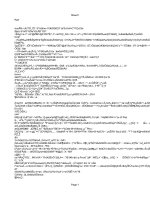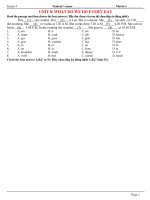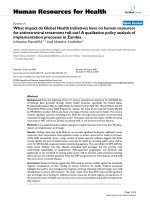Leadership Capability: “What We Do As a Leader”
Bạn đang xem bản rút gọn của tài liệu. Xem và tải ngay bản đầy đủ của tài liệu tại đây (157.7 KB, 10 trang )
<span class='text_page_counter'>(1)</span><div class='page_container' data-page=1>
Leadership Capability: “What We Do As a Leader”
<b>Abstract: As Roberto Goizueta in "From transactional to transformational leadership” [1]</b>, most
of the leaders always desire to bring success to his organization. The problem is that how much
extent of success reaching to, when it will come at, and whether it creates a turning point, a
breakthrough for individual leaders, organizations, and community or not. If an organization's
success primarily depends on effective work of each employee, the role of a leader is like a
catalyst which contributes to the efficiency to bring the organization to success. It is so
meaningful to understand who we are and what we want to be. Understanding the “Develop Our
Leadership Capability” is the first step helping us to recognize whether we have any traits or
factors of a leader or not, and what is the leadership model we own? In this paper, we are trying
to self-reflect those major keys learning on the author’s real aspects and ambition to identify her
own potential leadership model and developed it. We applied P.E.S.T.L analysis stands for
Political, Economic, Social, Technological, Legal and Environmental to analyze those models
we belong to and which may come at various time with various situations. During the course of
our life, we are absolutely encouraged to make a plan for future stable life. Hence, it is believed
that this paper is useful in helping one of us definite which our leadership model is.
<b>Keywords: leadership capability; leadership model; organization; management; effective work.</b>
<b>INTRODUCTION</b>
Entering the twenty-first century, the world has brought about enormous global changes. In the
last two decades of the twentieth century, humankind has witnessed the rapid development of
information technology, the revolution in biotechnology and especially the changes in the
concept of relationships. Human - Human in social relations, the role of human is more
important than ever. Nowadays, there will be no land for the existence of a director who just at
his seat, waiting for customers to buy products made by their own businesses and ignore the
needs and aspirations of customers. And no other leaders just screamed, shouted and waited for
subordinates to follow. Thus, in the new context of global development, in which Viet Nam
needs to integrate, it has laid down a fundamental requirement for new technical, technological,
training and thinking changes in leadership and management. A good future leader must have a
more realistic view of his value to the organization he manages [2]. He will have to exploit the
most human resources such as energy, intellect, enthusiasm, etc., around him. In order to achieve
this, the leader must have an important weapon in his or her hands, which is the style of
leadership.
</div>
<span class='text_page_counter'>(2)</span><div class='page_container' data-page=2>
individuals and collecting within the organization [4, 5]. The direction is a totally concrete
phenomenon, not repeated in the other person fully with detail. It is unique, unique in the way of
conducting leadership. Leadership style also affects the reputation of a leader and his
organizational reputation [6, 7], given that leadership style is the disclosure of qualities; capacity
is crystallized in the behavior of the brave leader. Leadership style is decided by virtue of the
overall quality of the leader largely. The development of qualities and leadership capacity will be
the decisive premise to perfect the leadership style [8-10]. Clearly, the leadership style is not
spontaneous. It is a process that is constantly evolving under the influence of objective and
subjective conditions. There is a misconception that innate behavior does not need to be trained
but also to be a good leader. The style is formed and developed by education, personal activity
and training [11]. Each leader must cultivate the ability to apply a flexible and rational system of
proven leadership methods and techniques through hands-on practice. Like other psychosocial
factors, the managerial style of the manager is the product of social life, which reflects the
functioning of the society, including the management mechanism.
In our country, in feudal society, patriarchal leadership, assertiveness, and imperialism are
predominantly because feudalism is a centralized regime. In a centralized subsidy mechanism,
collective style prevails and this mechanism attaches importance to collectivism. The new
management mechanism requires the leader to be determined, energetic and mentally dare to
take personal responsibility highly [12]. Thus, the decisive style of leadership has been replacing
the collective management style. This transformation is an indispensable necessity suitable for
the market economy. The market economy requires the leader to have a decisive style expressed
through the qualities of confidence, dare to think, dare to do, dare to serve, and dare to take
responsibility. It has been suggested that leaders must have this qualification to be successful
[13, 14]. An assertive style does not coincide with authoritarian style and patriarchal. Needless to
say, from assertiveness, confidence to patriarchy domination is only a very short distance. If the
leader is not clear, it is straightforward to become authoritarian autocrats [15, 16]. In the
globalization, leaders need to develop their own style, but shouldn’t try to pick or imitate any one
style [17]. The more a leader motivate and empower people, the more he takes the most positive
aspects of each style and incorporates the followers into his own [18, 19]. So studying the
leadership factors to find common rules, finding out the factors influencing and branding the
leader is very necessary. Employees can find a leader who fits their style to assist and vice versa
in order to have the most effective interaction in and the common goal for our organization.
<b>METHODOLOGY</b>
In order to get the most comprehensive information for this article, a number of methods are
used, including:
</div>
<span class='text_page_counter'>(3)</span><div class='page_container' data-page=3>
Research information collected was mostly from academic books, Google Scholar,
management news, and websites of various universities.
Analyzing: We started the analysis by considering expectations of a leader and their
followers. Applying the theories of leaderships such as Carl Jung’s theory, Multifactor
Leadership Questionnaires Form 5X-Short, Leader- Member Exchange Theory (LMX).
<b>RESULT AND DISCUSSION</b>
<b>Reflection on Leadership Models</b>
When we were a child, we may never think of anything else about leadership. As for the author,
when she was at 18 years old, she only wanted to become a doctor but she was not confident to
entry into the University of Medicine and Pharmacy. Hence, she chose Veterinarian Medicine
Surgeon Doctor and she passed the entrance examination with total scores that she could pass it
at the University of Medicine and Pharmacy. After 5 years working, she wanted to pursue her
studying but why it is Leadership but not any another one? She decided to apply for the Master
of Science in Leadership Course to find out her potential leadership in. She started to dream of
leadership. In her thought, a leader is the biggest and respected in front of all but still remains
"something" unclear, she cannot distinguish the difference between "leadership and management
until she reaches its definition in [11]. From [11], we could find 5 traits of leadership including
intelligence, self-confidence, determination, integrity and sociability. Hence, what leadership or
management is and how relevant it could be recognized the best leader or best manager,
<i>especially” leadership can be observed in leaders’ behaviors and can be learned", which shown</i>
in chapter 1, page 8 in [11]. This point absolutely encouraged the author to continue her
studying. Secondly, the measurement of technical, human, and conceptual emphasized in
competencies of leaders and managers. There are three major competencies such as
solving skills, social judgment skills and knowledge from page 48 to 52 in [11]. The
problem-solving skill is the ability in solutions to organizational problems at short-term and long-term
goals. The social judgment is a capacity to understand people and social system on page 46 in
[20]. Knowledge has a positive effect to how leaders deal with solving matters or troubles to
increase successful opportunity. Generally, the theory gave us clearly the requirements for the
<i>type of leader that we want to become; how fantastic is to be learned that “a leader stops to think</i>
the right and a manager acts the right think." Then, she always reminds herself of doing
something that "thinking first and doing then". Thirdly, “power" which has a close relation to
leadership, and management mentioned by the author; it's quite true, even a leader does concern
his chair because it shows his power in. However, power should be use and apply in right way to
create a positive influence in front of others.
</div>
<span class='text_page_counter'>(4)</span><div class='page_container' data-page=4>
experience, we agree that a leader cannot lead by using a single style, he must willing to change
their style to meet the requirements of the situation, understand his employees act differently
when doing different tasks; and the style belongs to various situations because there is a link
between styles and situations, how the company's organization is going on. In fact, situations are
always easily changed to match the leader’s style. Carl Jung’s theory at chapter 13 in [11], which
helps a leader reflect his personality types by many detail factors from the awareness, thought,
behavior, expression of action such as Functions and References, Extraversion and Introversion,
sensing and Intuition, thinking and feeling, Judging and Perceiving and she is interested in
"External and Internal” traits. As previous research, an internal leader often uses his ideas and
thoughts, listens, thinks and acts later [21]. The case 9.1 at page 206, Mr. Harold’s situation- A
vision Failed is extremely interesting [11]. That is really a practical case for those will be a
leader. It seems we are inside Harold’s matters. The case helps us to recognize the importance of
a key learning which helps us to definite problems and find a solution. We think Harold is so
hurried in his changing. To a new leader in a new organization, matters evaluation and its
relevant factors are essential. There is a famous statement from Uncle Ho that who knows people
who win people, hundred battles hundred wins and Dale Carnegie wrote in his book named
"How to win friend and influence people" are evidence for Harold's case [22]. We think that
who wants to become a true -good leader, they should keep this book beside and read it carefully
to get learning about work and life experiences.
</div>
<span class='text_page_counter'>(5)</span><div class='page_container' data-page=5>
can reach vice-director positions but there is a significant gap between the percentage of women
in vice-director positions and director positions. It shows that female leaders are more prevalent
in lower levels of the government. Therefore, for the female leaders face many challenges when
they take a role as a leader. Women are trying to balance professional work and personal life.
They may be un-encouraged by their husbands because most of husbands want their wife to do
housework, take care of baby, etc., and do not get more social relation than. Women often face
unbalance in sharing responsibilities so as to perform their professional work and personal life.
Despite country’s improvements in gender equality, Vietnamese women or women are lagging
behind their male counterparts as it comes to political and economic leadership in Viet Nam.
Only one-fourth of the members of the National Assembly are women, and women are
underrepresented in the leading bodies of the Party. Although women are very active in economy
and businesses they head, usually make less revenue than those headed by men. Nowadays, it is
said that women might rarely promote because of their weaknesses. Having read “Lean In” of
Sheryl Sandberg which may help the reader to find out the answer themselves, taking action in
order to seat on a leading table as Sheryl [28]. The case study of Pregnancy as a Barrier to Job
Status, chapter 14 in [11] reflects a real matter in Viet Nam. It has happened to several women
that holding a position as a team leader or management, and they are in so worried when they are
pregnant. What will happen then taking a 5 -month leave absence? Subsequently, women are less
return to work with a number of individual reasons. Perhaps, a mismatch in expectation between
employer and employee cause to ineffective works. At this point, we believe that "motivation"
will create value for an organization in general, for the leader privately.
Researching Uncle Ho’s Leadership style, help us to study the truthful leader portraits. Uncle Ho
was known as a great leader of Viet Nam Government from dependence to independence,
freedom, happiness and peace most of the time in over the world. We have learned that Ho Chi
Minh is a "determination" person shown during his leadership journey history, a great vision
strategist, a transformational leadership, an invariant-wise leadership and a servant leadership
also. It has pulled out that the effective leaders possess many different outstanding traits but
others [29-31].
<b>Understanding ourselves through the prism of strategic leadership </b>
<b>We could see the “stop and think” on page 108 in [32] that be useful to tomorrow leader.</b>
Although it’s short, its meaning is so wide. As aforementioned discussion, we might suggest
other “red flags” to be on the lookout for. If we find ourselves thinking (or others saying),
consider whether our biases are showing! The facts support our decision. Nothing bad will
happen. We’re ethical, and would not do anything bad. We have already invested so much. We
cannot afford to quit now.
</div>
<span class='text_page_counter'>(6)</span><div class='page_container' data-page=6>
helps us more to identify team members while working with them and be an advisor for
promotion with such key factors as questions: Do they keep an eye of individualism? Are they
good communicators? Or Are they a straight person? It means that the author applied the prior
hypothesis bias and a little of reasoning by analogy.
<b>As for the strategic making approach</b>
From the Figure 1.2 and 1.3 at the pages of 13 to 14, we completely agree with Henry Mintzberg
and A McGugh that emergent strategies are often successful and may be appropriate than
intended strategies [33]. In fact, the strategies of most of organizations are a combination of
planned (intended) and emergent. In chapter 1, Hill & Jones helped her make better strategic
decisions to achieve a competitive advantage in the future competitive environment.
<b>My personal leadership model </b>
During the research, we were known many leadership models and looked inside, compared with
real experience we recognized and anticipated that task motivated leadership and relationship
influence will be the most important and impactful in our future career, given that we are
looking for the answer to our own question: how a task motivated leader can influence our
followers best, in what way and what we should make a change, etc. The theory concerned
that a task motivated leader intends to focus on tasks and far away relationship. The
problem is where a sweet point for a leader’s career that the COPs model mentioned. For sure,
most of the leaders always spend or face to troubles, means "stresses", and those stresses will
occur to a task leader more often. Around these matters, the author does want to find solutions
of “keep and change” mind for her potential leadership style in order to touch a sweet point in
her career. For this reason, all points of chapters 6, 8, 9 and 13 were quite important in the
proceeding of evaluation ourselves [11].
To be an effective leader with strong knowledge and leadership skills, we should concern about
vision, long-term goals, standard, morality, ethics, caring and emotion. We recognize that “each
individual will see the effective works if we put “virtue mind” into what we are doing”.
Obviously, a great leader must have a virtue mind and outstanding traits. Accordingly, if he or
she is an excellent talent but he or she is poor at ethics, everything will be meaningless. We think
the transformational leadership style is the one we want to catch up with and follow. The
transformational leaders perform through four factors such as Idealized influence, Inspirational
motivation, Intellectual Stimulation and Individual Consideration [34]. The Multifactor
Leadership Questionnaires Form 5X-Short for transformational leadership at page 213 in [11] to
reflect leading capacity ourselves.
As herself-reflection:
</div>
<span class='text_page_counter'>(7)</span><div class='page_container' data-page=7>
leadership in future. However, most of the co- workers told her that she is so good at
social relations but rather strictly with the internal relationship because she herself does
not allow her to take so honesty or close relationship with staff, keep it at normal
conversation is better to work together. She is good at negotiation and marketing mind,
willing to share with others her experience; especially, she gets the trust from others as
well. She is determination one, determine to finish tasks given though they seem to be
hard. Besides, she often joins in social activities, volunteer program.
2. Inspirational motivation (4): Everyone has a reason for choosing work to do and most of
the employees think that they go to work for life, to earn money, to get a higher position.
Be a positive thinker, she often talks and motivate employee that they will receive equal
what they contribute. It encourages them to contribute more to work.
3. Intellectual Stimulation (2): she tends to work independently and prefer to follow the
existing procedure to do work. By this way, a person who creates procedure will feel
valued and respected in ordered organization. However, she breaks a procedure, cut or
jump over some steps in urgent cases. Sometimes, her employees do the same, and I feel
alright with the results they achieve.
<i>4. Individualized consideration (4): she helps and guides others to develop their strengths,</i>
<i>their career. She is a good listener. To her, sharing is caring, so she often shares to her </i>
co-workers and friends how to solve the problems, what needs to learn to strengthen their
competency.
Many personality surveys helped the author to know who she is. The result was the command
(ENTJ), Introversion, Intuition, Thinking and Judging at page 330 to 335 [11]. However, reading
up to the sensor, the author still sees herself inside too, it’s right under assistant role, whereas,
intuition reflects her own as operation management. Hence, whether the forming of personality
type can be changed depending on the situation at that time or not? She is working both
connecting to all Depts. and solving problem independently, directing matters; in operating
management position, She has a right to make her own decision, so these chapters look helpful to
her in influence followers. At present, the author thinks that the Leader- Member Exchange
Theory (LMX) in chapter 8 reflected her relation that is in the middle of phase 2 and 3 [11].
Again, it is a chance to overview and re-clarifies oneself with LMX questionnaire to find the
good changes in their behaviors, gradually changed toward the positive application, in detail:
1. Introvert: she is getting the energy from inside, getting information through reading or
watching informative television shows. She prefers to listen more than talk.
</div>
<span class='text_page_counter'>(8)</span><div class='page_container' data-page=8>
3. Thinker: She is a type of person to use data to make a decision. She looks the problem
with the logic, objective and analytical. Any decision made based on a certain trustful
information level.
4. Judge: She is decisive and deliberate. In the work, she prefers to work through guideline,
procedure, process, and schedule. She requires clear target and objective and commitment
from followers.
<b>CONCLUSION</b>
Leadership models may be defined as guides that suggest specific leadership behaviors
use in specific environment or situation. In addition, they often use a graphic
representation to visually show the required leadership behavior. According to John C.
Maxwell, Developing the leader within you, there are more 4 models/ types of leaders such
as a super leader, an erudite leader, a potential leader and a limited leader [35]. Moreover,
similarities and differences of each type will be affected by others external environment factors
because an organization is becoming influenced increasingly by the external environment that
leaders create. Hence, we would recommend to apply P.E.S.T.L.E analysis stands for Political,
Economic, Social, Technological, Legal and Environmental to analyze those models which may
come at a various time with various situations [11, 32] [29].
</div>
<span class='text_page_counter'>(9)</span><div class='page_container' data-page=9>
results. I know who I am, and all of us have the spark of leadership inside our human beings. The
challenge is to understand ourselves well enough to discover where we can use our leadership
capacity to serve others.
<b>My Leadership Definition</b>
After analyzing all elements related to leadership model and its concept, the author has got that:
<i>“Leadership is a capability of a person who has seductive behaviors with vision and marketing</i>
<i>skills that able to transmit vision to others and inspire them to get cooperation but competition</i>
<i>among members.”</i>
<b>References:</b>
[1] B. M. Bass, "From transactonal to transformatonal leadership: Learning to share the vision,"
<i>Organizatinal dynamics, vol. 18, pp. 19-31, 1990.</i>
[2] Mapes. (1991) Strategic Vision. <i> SKY</i> <i>Magazine.</i> Available:
/>
[3] <i>A. Zaleznik, "Managers and leaders: are they diferentt," Clinical leadership & management</i>
<i>review: the jiurnal if CLMA, vol. 18, pp. 171-177, 200/.</i>
[/] <i>T. A. Amabile and M. Khaire, Creatvity and the rile if the leader: Harvard Business School</i>
Publishing, 2008.
[5] <i>A. Murray, "Leadership styles," Adapted frim “The Wall Street Jiurnal Guide ti Management,”</i>
<i>Published by Harper Business, pp. 1-5, 2013.</i>
[6] A. T. Hall, F. R. Blass, G. R. Ferris, and R. Massengale, "Leader reputaton and accountability in
<i>organizatons: Implicatons for dysfunctonal leader behavior," The Leadership Quarterly, vol. 15,</i>
pp. 515-536, 200/.
[7] L. R. Men and D. W. Stacks, "The impact of leadership style and employee empowerment on
<i>perceived organizatonal reputaton," Jiurnal if Cimmunicatin Management, vol. 17, pp. </i>
171-192, 2013.
[8] <i>Tasneem. (9th Sept. ). Leadership – Quality, Signifcance & Leadership Qualites. Available:</i>
/>
[9] G. Hernez-Broome and R. L. Hughes, "Leadership development: Past, present, and future,"
<i>Peiple and Strategy, vol. 27, p. 2/, 200/.</i>
[10] <i>R. G. Lord and R. J. Hall, "Identty, deep structure and the development of leadership skill," The</i>
<i>Leadership Quarterly, vol. 16, pp. 591-615, 2005.</i>
[11] <i>P. G. Northouse, Leadership: Theiry and practce vol. 6: Sage, 2012.</i>
[12] L. J. Christensen, A. Mackey, and D. Whetten, "Taking responsibility for corporate social
responsibility: The role of leaders in creatng, implementng, sustaining, or avoiding socially
<i>responsible irm behaviors," The Academy if Management Perspectves, vol. 28, pp. 16/-178,</i>
201/.
[13] J. Boyle, "11 slogans that changed China," ed.
BBC News, 2013.
[1/] <i>C. Bachelder, Dare ti serve: Hiw ti drive superiir results by serving ithers: Berrett-Koehler</i>
Publishers, 2015.
</div>
<span class='text_page_counter'>(10)</span><div class='page_container' data-page=10>
[16] <i>B. M. Bass and R. M. Stogdill, Handbiik if leadership vol. 11: New York: free press, 1990.</i>
[17] <i>K. Eikenberry, Remarkable leadership: Unleashing yiur leadership pitental ine skill at a tme</i>
vol. /9: John Wiley & Sons, 2011.
[18] <i>D. Morgan. (2016, Sept). Develiping an efectve leadership style. Available: </i>
/>[19] K. EIkenberry. (2013, Sept). <i> Finding Yiur Leadership Style. Available:</i>
/>[20] S. J. Zaccaro, M. D. Mumford, M. S. Connelly, M. A. Marks, and J. A. Gilbert, "Assessment of
<i>leader problem-solving capabilites," The Leadership Quarterly, vol. 11, pp. 37-6/, 2000.</i>
[21] <i>J. B. Kahnweiler, "Why Introverts Can Make the Best Leaders," FORBES, vol. 18/, pp. 8-8, 2009.</i>
[22] <i>D. Carnegie, Hiw ti win friends and infuence peiple: Simon and Schuster, 2010.</i>
[23] A. Mishkind, "Evidence-based professional learning," ed: Research Brief, 201/.
[2/] W. Nash, "INDIGENOUS HEALTH’S GODLIKE NEMESIS: MOUNTAINS BEYOND MOUNTAINS AS
<i>VECTOR FOR THE “HEALTH” OF THE RICH AND POWERFUL," in Catalyst: A Sicial Justce Firum,</i>
201/, p. 2.
[25] <i>A. Crane, The Oxfird handbiik if cirpirate sicial respinsibility: Oxford Handbooks, 2008.</i>
[26] <i>P. Kotler and N. Lee, Cirpirate sicial respinsibility: Diing the mist giid fir yiur cimpany and</i>
<i>yiur cause: John Wiley & Sons, 2008.</i>
[27] <i>J. Munro and U. Of, Wimen's Representatin in Leadership in Viet Nam, 2012.</i>
[28] <i>S. Sandberg, Lean in: Wimen, wirk, and the will ti lead: Random House, 2013.</i>
[29] <i>H. C. Minh, Tiàn tập vol. 5: NXB CTQG Hà Nội, 2009.</i>
[30] <i>H. C. Minh, Tiàn tập vol. /: NXB CTQG Hà Nội 2000.</i>
[31] <i>H. C. Minh, Sửa đổi lối làm việc vol. 5: NXBCTQG Hà Nội, 2002.</i>
[32] <i>K. A. Nelson and L. K. Treviño, Managing business ethics: Straight talk abiut hiw ti di it right</i>
vol. 6: Wiley, 200/.
[33] <i>G. R. Jones and C. W. Hill, Strategic management essentals vol. 3: South-Western Cengage</i>
Learning, 2012.
[3/] <i>P. G. Northouse, Leadership,Theiry and Practce Sixth Editin: SAGE Publicatons, Inc., 2012.</i>
[35] <i>J. C. Maxwell, Develiping the leader within yiu: Thomas Nelson Inc, 1993.</i>
Author’s Biography
Sang Tran Kim
Education: Master of science in Leadership
Organization: Galaxy Language Center
Dept.: research Dept.
Email:
Tel: 091 887 1959
</div>
<!--links-->









